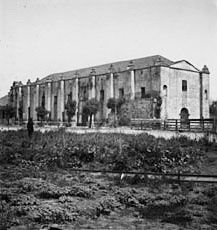 |
| English: Mission San Gabriel Arcángel Cemetery (Photo credit: Wikipedia) |
 |
| Mission San Gabriel Archangels in San Gabriel, California around 1900 (Photo credit: Wikipedia) |
The Tongva natives inhabited the area now known as Long Beach many years before 1542, when the European Juan Rodriguez Cabrillo "discovered" this special land on the West Coast. Two hundred years later, the Spanish returned and the Tongva were pressed into slavery by the Catholic missionaries. Eventually, the Tongva (which translates as "people of the earth") were renamed San Gabriel Mission Indians or Gabrielinos after the Mission San Gabriel Arcangel, where they were forced to work the land and tend cattle and sheep.
The priests who found the 21 missions in California, copied the European tradition of including cemeteries on church grounds. According to archeologists, the earliest Tongva utilized funeral pyres (ahtochgnah) to cremate their dead. The bones and ashed, called kooseerok, were then scattered to the east. Burial sites were called koonasga. A deeply spiritual people, the Tongva participated in a Tongva mortuary ceremony. Every one to four years, the tribe would hold a "cry" ceremony lasting for 16 days for the people who died since the last ceremony. They would dig a hole and place a fire at the bottom. Bones of the dead would be placed in the fire hole and then covered. Cremation and Tongva mortuary rites were considered paga by the Catholic missionaries and forbidden.
 |
| Rancho Los Alamitos |
In the 1990s, CSULB officials planned to develop an open field on campus adjacent to the Japanese Gardens, into a mini mall. Students and others protested with flyers declaring "Save It, Don't Pave It" and "Go Dig Up Your Own Grandmother." The development was stopped. Students periodically claim that the field, which is often covered in fog, is haunted.